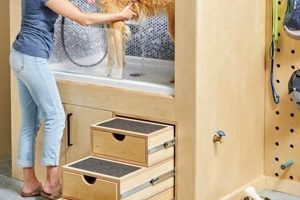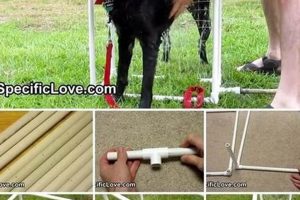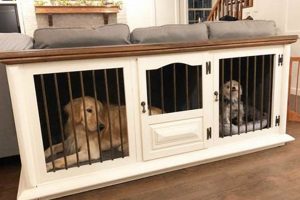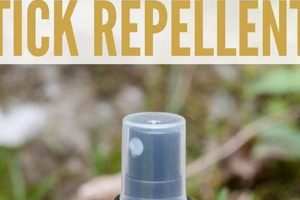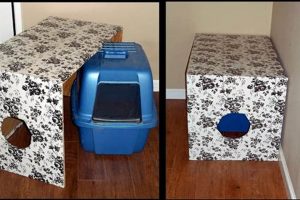Homemade interactive toys designed to challenge and entertain canines are a form of enrichment. These activities stimulate a dog’s natural foraging instincts and problem-solving abilities. Examples include modified plastic bottles with hidden treats, or fabric snuffle mats where food is concealed within layers of material.
The use of these homemade enrichment devices can promote mental stimulation, reduce boredom, and alleviate destructive behaviors commonly associated with insufficient activity. Historically, providing animals with engaging tasks mirrors natural hunting and scavenging routines, contributing to their overall well-being and psychological health.
The subsequent discussion will delve into the practical considerations for constructing these engaging items, including material selection, safety precautions, and a variety of design possibilities. These elements combine to give you a better view on the topic.
Tips for Creating Engaging Homemade Canine Enrichment Activities
Constructing safe and effective enrichment items requires careful planning and execution. Adherence to specific guidelines minimizes potential risks and maximizes the benefits for the animal.
Tip 1: Material Selection: Opt for durable, non-toxic materials. Avoid small parts that could be ingested, as well as substances that might splinter or shatter. Examples include heavy-duty plastics, thick fleece, and untreated wood.
Tip 2: Structural Integrity: Ensure the construction is robust and free from sharp edges or weak points. Securely fasten all components to prevent separation during use, which could pose a choking hazard.
Tip 3: Gradual Introduction: Introduce the puzzle gradually, initially making it easy to solve. As the dog becomes more proficient, increase the complexity to maintain engagement and prevent frustration.
Tip 4: Supervised Play: Always supervise the dog during play, especially when introducing a new puzzle. This allows for immediate intervention if the dog attempts to destroy or ingest the item.
Tip 5: Hygiene Maintenance: Regularly clean the puzzle to prevent the build-up of bacteria and food residue. Use appropriate cleaning agents that are safe for animal contact.
Tip 6: Variety and Rotation: Offer a variety of puzzles to maintain interest and prevent boredom. Rotate the puzzles regularly to provide novel challenges.
Tip 7: Consider Dog’s Abilities: Take into account the dog’s size, breed, and physical capabilities when designing and selecting puzzle types. Adjust the difficulty level accordingly.
By adhering to these guidelines, individuals can effectively promote canine mental stimulation, encourage problem-solving, and enhance overall well-being. The careful and thoughtful application of these tips can transform ordinary materials into instruments of canine enrichment.
The following sections will explore specific design ideas and address frequently asked questions regarding the creation and use of these enrichment devices.
1. Safety
Safety is paramount when creating interactive enrichment devices for canines. Neglecting this principle can lead to physical harm, necessitating careful consideration of materials and design.
- Material Toxicity
The selection of non-toxic materials is essential. Certain plastics, paints, and adhesives contain chemicals harmful if ingested. Prioritize materials labeled as food-grade or pet-safe. For instance, PVC pipes, though durable, may contain phthalates. Alternatives include untreated wood or heavy-duty, BPA-free plastics.
- Choking Hazards
Small parts represent a significant choking risk. Securely fasten all components and avoid using items that can easily be broken or chewed into small pieces. This includes buttons, beads, and loosely attached fabrics. Consider the dog’s chewing habits when choosing materials and designs.
- Sharp Edges and Points
Ensure all edges and points are smooth and rounded to prevent cuts and abrasions. Sand down any rough surfaces on wooden components and cover any exposed sharp edges on plastic materials. Frequent inspection of the toy is recommended to identify and address any developing sharp points.
- Supervision
Even with careful design and construction, constant monitoring of a canine’s interaction with homemade puzzles can help. Immediate intervention becomes important to prevent harmful chewing or ingestion of any parts. Proper use is more suitable than improper construction.
These considerations underscore the importance of a proactive approach to safety in the creation of interactive canine toys. Rigorous evaluation of materials and designs, coupled with consistent supervision, minimizes risk and maximizes the benefits of canine enrichment. These steps transform what might have been a possible risk to an experience of enriching activities.
2. Durability
Durability constitutes a critical factor in the design and construction of homemade canine enrichment devices. The lifespan of interactive toys directly influences their cost-effectiveness and the safety of the animal. The selection of resilient materials and robust construction techniques are essential to mitigate potential hazards and maximize the value of these items.
- Material Resistance to Chewing
Material selection should account for the dog’s chewing habits. Certain breeds exhibit a propensity for aggressive chewing, necessitating the use of highly resistant materials. Examples include thick, untreated wood, heavy-duty canvas, and reinforced plastics. Materials prone to splintering or shattering should be avoided due to the risk of ingestion and injury.
- Structural Integrity Under Stress
The construction method should ensure that the puzzle can withstand repeated use and manipulation. Secure fastening techniques, such as strong adhesives, screws, or stitching, are necessary to prevent components from detaching. Weak joints or poorly secured parts can create choking hazards and reduce the overall lifespan of the toy. Pressure distribution should be considered.
- Weather Resistance (for Outdoor Use)
If the enrichment device is intended for outdoor use, weather resistance becomes a crucial consideration. Materials should be able to withstand exposure to moisture, sunlight, and temperature fluctuations. Treated wood, weather-resistant fabrics, and rust-proof hardware are suitable choices. Regular maintenance may be required to prolong the lifespan of outdoor puzzles.
- Resistance to Sanitation Processes
The chosen materials should withstand repeated cleaning and disinfection. Puzzles can accumulate bacteria and food residue, necessitating regular sanitation to maintain hygiene. Materials should be non-porous and resistant to degradation from cleaning agents. Dishwasher-safe materials are particularly convenient.
The incorporation of durable elements in the construction of canine enrichment devices contributes to their long-term utility and minimizes potential risks. By considering the factors that influence durability, individuals can create safe, cost-effective puzzles that enhance the cognitive and physical well-being of their canine companions. Investing in resilient materials and construction techniques represents a commitment to the animal’s long-term enrichment and safety.
3. Stimulation
Canine enrichment devices, particularly those of the homemade variety, serve as crucial tools for providing mental stimulation. A lack of adequate mental engagement can lead to behavioral issues, such as excessive barking, destructive chewing, and restlessness. Constructing these puzzles addresses this deficiency by challenging the dog’s problem-solving abilities and natural foraging instincts. For example, a simple puzzle involving hiding treats under cups requires the dog to employ cognitive skills to locate the reward, stimulating its mind in a manner analogous to hunting for food.
The stimulation provided by these interactive games extends beyond mere entertainment. It contributes to cognitive development and maintenance, similar to how mental exercises benefit humans. Regularly engaging with puzzles can improve a dog’s focus, memory, and overall cognitive function. Furthermore, these activities can be tailored to suit different dog breeds and age groups. For instance, a senior dog might benefit from a less complex puzzle that focuses on scent detection, while a younger, more energetic dog could tackle a more challenging puzzle requiring physical dexterity and strategic thinking. The adaptability of homemade puzzles allows for personalized cognitive enrichment.
In summary, the connection between canine enrichment activities and mental well-being is undeniable. Providing ample opportunity to stimulate natural cognitive skills can lead to a calmer, more focused, and ultimately happier dog. Furthermore, understanding how to create enriching experiences enables handlers to better connect with their animals, fostering a stronger bond. This method allows users to create a long and enduring relationships.
4. Accessibility
Accessibility, in the context of homemade canine enrichment devices, refers to the ease with which a dog can interact with and successfully complete a puzzle. This is directly proportional to the puzzle’s efficacy in providing mental stimulation and preventing frustration. A puzzle that is too difficult or physically inaccessible can lead to discouragement, negating the intended benefits. Conversely, overly simple puzzles offer minimal cognitive challenge.
Factors influencing accessibility include the size and shape of the puzzle components, the required motor skills, and the complexity of the problem-solving tasks. For example, a large breed dog with limited dexterity may struggle with a puzzle that requires manipulating small, intricate parts. Similarly, a visually impaired dog may benefit from puzzles that rely heavily on olfactory cues. Tailoring the puzzle to the dog’s physical and cognitive capabilities is paramount.
The significance of understanding accessibility lies in the ability to create puzzles that are both challenging and achievable. Successful puzzle completion reinforces positive behavior and promotes a sense of accomplishment. By carefully considering a dog’s individual characteristics, homemade enrichment devices can be optimized for maximum engagement and benefit. Failure to account for accessibility can result in a wasted effort, potentially exacerbating behavioral issues rather than alleviating them.
5. Cleanliness
Maintaining appropriate hygiene in homemade canine enrichment devices constitutes a critical aspect of responsible pet ownership. These devices, designed to stimulate and entertain, often involve food or treats, creating an environment conducive to bacterial growth and potential health risks.
- Material Selection and Sanitation
Porous materials, such as untreated wood or certain fabrics, can harbor bacteria and are difficult to thoroughly clean. Non-porous materials like food-grade plastic or stainless steel are preferable due to their ease of sanitation. Regular cleaning with pet-safe disinfectants is essential to prevent the build-up of harmful microorganisms.
- Food Residue Removal
Accumulated food residue serves as a breeding ground for bacteria and can attract pests. Puzzle designs should facilitate easy removal of food particles. Features such as removable compartments or wide openings aid in thorough cleaning. Regular inspection and prompt removal of any residual food are imperative.
- Preventing Mold and Mildew
Moisture can promote the growth of mold and mildew, particularly in puzzles used outdoors or those exposed to saliva. Proper drying after cleaning is crucial. Storage in a well-ventilated area minimizes the risk of mold formation. Inspecting puzzles regularly for signs of mold or mildew is recommended.
- Impact on Canine Health
Inadequate hygiene in enrichment devices can lead to various health issues in dogs, including gastrointestinal upset, allergic reactions, and infections. Regularly cleaning and disinfecting these toys minimizes the risk of exposure to harmful pathogens, contributing to the animal’s overall well-being.
The connection between hygiene and the safety of homemade canine enrichment activities cannot be overstated. A proactive approach to cleanliness, encompassing material selection, sanitation practices, and regular inspection, is essential for safeguarding canine health and maximizing the benefits of these interactive toys.
6. Adaptability
Adaptability plays a vital role in the creation and implementation of homemade canine enrichment devices. Its importance stems from the diverse needs and capabilities of individual dogs. A puzzle designed for a large breed with advanced problem-solving skills will likely be unsuitable for a smaller, less experienced dog. This discrepancy highlights the need for customizable elements within the design to ensure both engagement and success. The absence of adaptability can result in frustration for the animal, negating the intended benefits of mental stimulation and potentially leading to behavioral issues.
Examples of adaptive features include adjustable difficulty levels, variable treat compartment sizes, and modular components that can be added or removed. A puzzle initially presented with easily accessible rewards can be modified to require more complex manipulations as the dog’s proficiency increases. Similarly, puzzles intended for dogs with physical limitations can be adapted to minimize the need for excessive movement or reaching. Practical application involves careful observation of the dog’s interaction with the puzzle, noting areas of struggle or disinterest, and then adjusting the design accordingly.
In summary, adaptability represents a critical component of effective homemade canine enrichment. Recognizing the unique characteristics of each dog and incorporating customizable features into puzzle designs ensures optimal engagement and prevents frustration. This approach maximizes the potential benefits of mental stimulation and promotes positive behavioral outcomes. Addressing this challenge by constantly varying the difficulty is part of creating enriching activities for dogs.
7. Engagement
Engagement forms the cornerstone of successful implementation of homemade canine enrichment activities. A puzzle, regardless of its ingenuity or construction quality, proves ineffective if it fails to capture and maintain the dog’s interest. The level of engagement directly influences the degree of mental stimulation achieved, which in turn impacts behavior modification and overall well-being. A disengaged dog derives no cognitive benefit and may, in fact, experience frustration or boredom, potentially leading to destructive behaviors. For example, a puzzle with treats that are too difficult to access might initially pique the dog’s interest but quickly result in abandonment due to a lack of achievable reward. This illustrates the causal link between accessible challenge and sustained interaction.
Sustained engagement relies on several factors, including novelty, challenge level, and reward frequency. Puzzles that are easily solved lose their appeal over time, necessitating periodic alterations or the introduction of new designs. The challenge presented should be appropriately calibrated to the dog’s cognitive abilities, offering a degree of difficulty that encourages problem-solving without causing undue frustration. Furthermore, the anticipation of reward, typically in the form of food or treats, serves as a primary motivator for continued interaction. Real-world examples of successful engagement include puzzles that mimic natural foraging behaviors, such as hiding treats in layers of fabric or requiring the dog to manipulate objects to access a hidden compartment. These activities tap into innate instincts, sustaining interest for extended periods.
In summary, engagement is not merely a desirable attribute but a critical determinant of the efficacy of homemade canine enrichment. Thoughtful consideration of factors such as novelty, challenge, and reward frequency, coupled with continuous observation and adaptation, ensures that puzzles effectively capture the dog’s attention and deliver the intended cognitive benefits. The challenge lies in maintaining a dynamic balance between simplicity and complexity, adapting to the evolving needs and abilities of the individual animal to foster sustained interest and positive behavioral outcomes.
Frequently Asked Questions
This section addresses common inquiries regarding the creation and utilization of “diy dog puzzle games,” providing informative answers to enhance comprehension and promote responsible implementation.
Question 1: What materials are safe for constructing canine puzzles?
Acceptable materials include food-grade plastics, untreated wood, and durable, non-toxic fabrics. Avoid items containing small parts, sharp edges, or chemicals that could be harmful if ingested.
Question 2: How can the difficulty of a homemade puzzle be adjusted?
Difficulty can be modified by altering the complexity of the task, the size of the treat compartments, or the number of steps required to obtain the reward. Gradual increases in difficulty prevent frustration.
Question 3: How often should canines interact with these enrichment devices?
Frequency depends on the individual dog’s needs and energy levels. However, short, frequent sessions are generally more effective than infrequent, prolonged sessions. Supervised interaction is always recommended.
Question 4: What are the signs of a dog becoming frustrated with a puzzle?
Signs of frustration include whining, excessive pawing, destructive behavior directed at the puzzle, or complete disengagement. Adjust the puzzle’s difficulty if these behaviors are observed.
Question 5: How can hygiene be maintained in enrichment devices?
Regular cleaning with pet-safe disinfectants is essential. Select materials that are easily sanitized and allow for thorough removal of food residue. Ensure the puzzle is completely dry before reuse.
Question 6: Are there any breed-specific considerations for puzzle design?
Yes. Consider the dog’s breed characteristics, such as scenting abilities, chewing tendencies, and physical capabilities. Tailor the puzzle to align with these traits for optimal engagement.
In conclusion, a thorough understanding of safety considerations, adaptability, and hygiene practices is essential for the successful and responsible creation and use of homemade canine enrichment devices.
The following section will delve into specific examples of enrichment activities.
Conclusion
The preceding discussion has illuminated diverse facets of “diy dog puzzle games,” emphasizing their role in canine cognitive enrichment and behavioral management. Examination of material selection, safety protocols, adaptability, and engagement strategies underscores the importance of a holistic approach to their construction and implementation. The efficacy of these homemade devices rests on a foundation of responsible design and consistent maintenance.
The future of canine enrichment lies in continued innovation and refinement of puzzle designs, driven by a deeper understanding of canine cognition and behavior. A commitment to responsible creation and utilization of these tools will contribute to improved animal welfare and strengthened human-animal bonds. The continued exploration of safe, effective, and engaging “diy dog puzzle games” represents a valuable investment in the cognitive and emotional well-being of canine companions.


